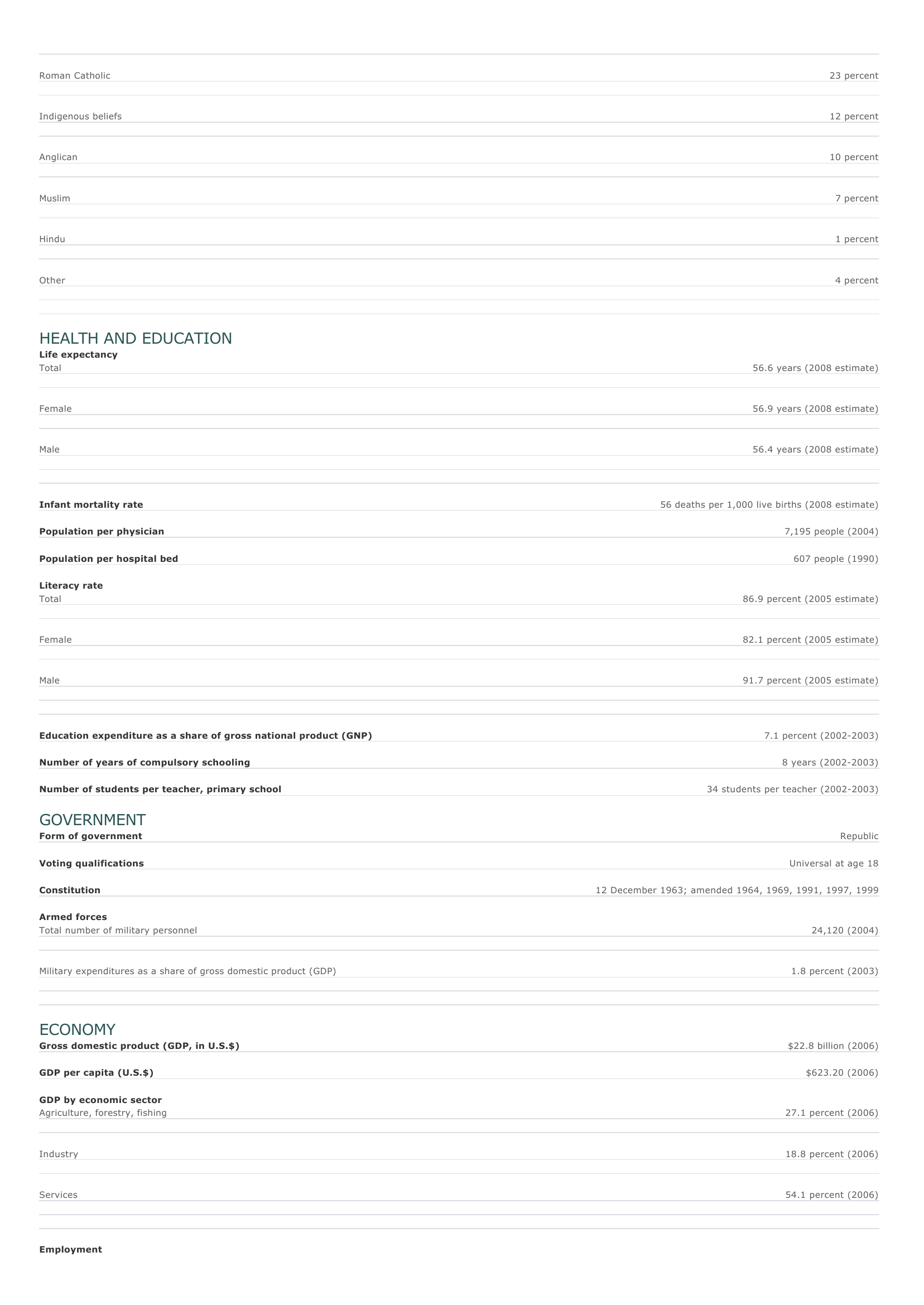
Kenya Facts and Figures. BASIC FACTS Official name Capital Area Republic of Kenya Nairobi 582,646 sq km 224,961 sq mi PEOPLE Population 37,953,838 (2008 estimate) Population growth Population growth rate 2.76 percent (2008 estimate) Projected population in 2025 51,261,167 (2025 estimate) Projected population in 2050 65,175,864 (2050 estimate) Population density 67 persons per sq km (2008 estimate) 173 persons per sq mi (2008 estimate) Urban/rural distribution Share urban 42 percent (2005 estimate) Share rural 58 percent (2005 estimate) Largest cities, with population Nairobi 2,575,000 (2003 estimate) Mombasa 660,800 (1999) N akuru 219,366 (1999) Kisumu 194,390 (1999) Eldoret 137,016 (1999) Ethnic groups Kikuyu 21 percent L uhya 14 percent Luo 12 percent Kalenjin 11 percent Kamba 11 percent Kisii 6 percent M eru 6 percent O ther 19 percent Languages English (official), Swahili or Kiswahili (official), Kikuyu, Luo, numerous other indigenous languages Religious affiliations Protestant 43 percent Roman Catholic 23 percent Indigenous beliefs 12 percent Anglican 10 percent Muslim 7 percent Hindu 1 percent O ther 4 percent HEALTH AND EDUCATION Life expectancy Total 56.6 years (2008 estimate) Female 56.9 years (2008 estimate) Male 56.4 years (2008 estimate) Infant mortality rate Population per physician Population per hospital bed 56 deaths per 1,000 live births (2008 estimate) 7,195 people (2004) 607 people (1990) Literacy rate Total 86.9 percent (2005 estimate) Female 82.1 percent (2005 estimate) Male 91.7 percent (2005 estimate) Education expenditure as a share of gross national product (GNP) Number of years of compulsory schooling Number of students per teacher, primary school 7.1 percent (2002-2003) 8 years (2002-2003) 34 students per teacher (2002-2003) GOVERNMENT Form of government Republic Voting qualifications Universal at age 18 Constitution Armed forces Total number of military personnel Military expenditures as a share of gross domestic product (GDP) 12 December 1963; amended 1964, 1969, 1991, 1997, 1999 24,120 (2004) 1.8 percent (2003) ECONOMY Gross domestic product (GDP, in U.S.$) GDP per capita (U.S.$) $22.8 billion (2006) $623.20 (2006) GDP by economic sector Agriculture, forestry, fishing 27.1 percent (2006) I ndustry 18.8 percent (2006) Services 54.1 percent (2006) Employment Number of workers 16,650,475 (2006) Workforce share of economic sector Agriculture, forestry, fishing 19 percent (2002) I ndustry 20 percent (2002) Services 62 percent (2002) Unemployment rate 21.3 percent (1994) National budget (U.S.$) Total revenue $3,357 million (2004) Total expenditure $3,217 million (2004) Monetary unit 1 Kenya shilling (Ksh), consisting of 100 cents Major trade partners for exports Uganda, United Kingdom, Netherlands, Pakistan, and United States Major trade partners for imports United States, United Arab Emirates, Saudi Arabia, South Africa, and United Kingdom ENERGY, COMMUNICATIONS, AND TRANSPORTATION Electricity production Electricity from thermal sources 17.76 percent (2003 estimate) Electricity from hydroelectric sources 74.30 percent (2003 estimate) Electricity from nuclear sources Electricity from geothermal, solar, and wind sources Number of radios per 1,000 people 0 percent (2003 estimate) 7.95 percent (2003 estimate) 229 (2000 estimate) Number of telephones per 1,000 people 8 (2005) Number of televisions per 1,000 people 26 (2000 estimate) Number of Internet hosts per 10,000 people Daily newspaper circulation per 1,000 people Number of motor vehicles per 1,000 people Paved road as a share of total roads 2.6 (2003) 9 (1996) 18 (2004) 14 percent (2004) SOURCES Basic Facts and People sections Area data are from the statistical bureaus of individual countries. Population, population growth rate, and population projections are from the United States Census Bureau, International Programs Center, International Data Base (IDB) (www.census.gov). Urban and rural population data are from the Food and Agriculture Organization (FAO) of the United Nations (UN), FAOSTAT database (www.fao.org). Largest cities population data and political divisions data are from the statistical bureaus of individual countries. Ethnic divisions and religion data are largely from the latest Central Intelligence Agency (CIA) World Factbook and from various country censuses and reports. Language data are largely from the Ethnologue, Languages of the World, Summer Institute of Linguistics International (www.sil.org). Health and Education section Life expectancy and infant mortality data are from the United States Census Bureau, International Programs Center, International database (IDB) (www.census.gov). Population per physician and population per hospital bed data are from the World Health Organization (WHO) (www.who.int). Education data are from the United Nations Educational, Scientific and Cultural Organization (UNESCO) database (www.unesco.org). Government section Government, independence, legislature, constitution, highest court, and voting qualifications data are largely from various government Web sites, the latest Europa World Yearbook, and the latest Central Intelligence Agency (CIA) World Factbook. The armed forces data is from Military Balance. Economy section Gross domestic product (GDP), GDP per capita, GDP by economic sectors, employment, and national budget data are from the World Bank database (www.worldbank.org). Monetary unit, agriculture, mining, manufacturing, exports, imports, and major trade partner information is from the statistical bureaus of individual countries, latest Europa World Yearbook, and various United Nations and International Monetary Fund (IMF) publications. Energy, Communication, and Transportation section Electricity information is from the Energy Information Administration (EIA) database (www.eia.doe.gov). Radio, telephone, television, and newspaper information is from the United Nations Educational, Scientific and Cultural Organization (UNESCO) database (www.unesco.org). Internet hosts, motor vehicles, and road data are from the World Bank database (www.worldbank.org). Note Figures may not total 100 percent due to rounding. Microsoft ® Encarta ® 2009. © 1993-2008 Microsoft Corporation. All rights reserved.





